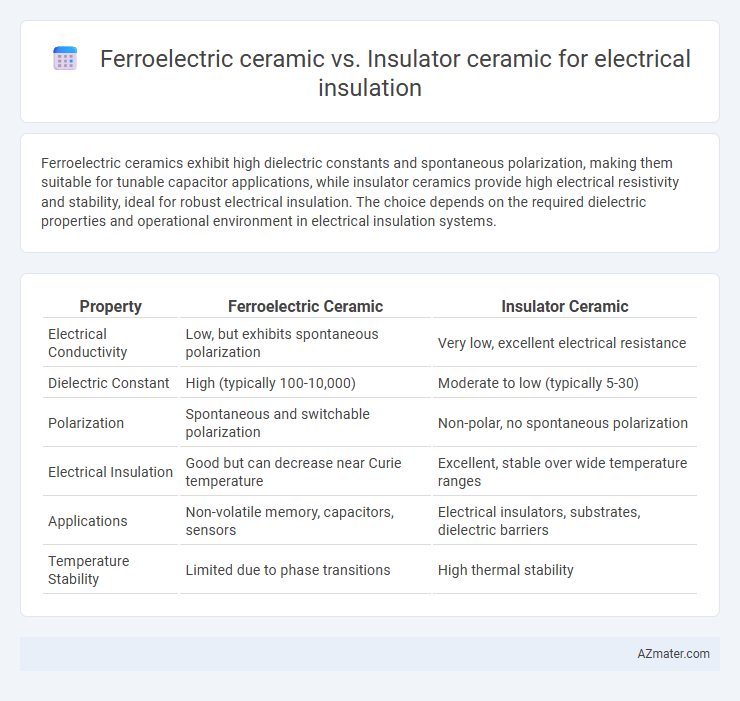Ferroelectric ceramics exhibit high dielectric constants and spontaneous polarization, making them suitable for tunable capacitor applications, while insulator ceramics provide high electrical resistivity and stability, ideal for robust electrical insulation. The choice depends on the required dielectric properties and operational environment in electrical insulation systems.
Table of Comparison
| Property | Ferroelectric Ceramic | Insulator Ceramic |
|---|---|---|
| Electrical Conductivity | Low, but exhibits spontaneous polarization | Very low, excellent electrical resistance |
| Dielectric Constant | High (typically 100-10,000) | Moderate to low (typically 5-30) |
| Polarization | Spontaneous and switchable polarization | Non-polar, no spontaneous polarization |
| Electrical Insulation | Good but can decrease near Curie temperature | Excellent, stable over wide temperature ranges |
| Applications | Non-volatile memory, capacitors, sensors | Electrical insulators, substrates, dielectric barriers |
| Temperature Stability | Limited due to phase transitions | High thermal stability |
Introduction to Electrical Insulator Ceramics
Electrical insulator ceramics, used to prevent electrical current flow, exhibit high dielectric strength and thermal stability. Ferroelectric ceramics distinguish themselves by possessing spontaneous polarization reversible under an electric field, enabling applications in sensors and actuators, whereas standard insulating ceramics primarily offer high resistivity and mechanical robustness. Material choices like alumina or zirconia focus on electrical insulation with minimal dielectric loss, while ferroelectric types such as barium titanate provide additional functionalities beyond insulation.
Overview of Ferroelectric Ceramic Materials
Ferroelectric ceramic materials, such as barium titanate (BaTiO3) and lead zirconate titanate (PZT), exhibit spontaneous polarization that can be reversed by an external electric field, distinguishing them from conventional insulator ceramics like alumina (Al2O3) or zirconia (ZrO2). These materials possess high dielectric constants and strong piezoelectric properties, making them essential in capacitors, sensors, and actuators within electrical insulation systems. While insulator ceramics primarily provide high electrical resistivity and thermal stability, ferroelectric ceramics offer multifunctional capabilities combining insulation with tunable dielectric and electromechanical properties.
Properties of Insulator Ceramic Materials
Insulator ceramic materials exhibit high electrical resistivity, low dielectric loss, and strong thermal stability, making them ideal for electrical insulation applications. Ferroelectric ceramics differ by possessing spontaneous polarization that can be reversed by an electric field, resulting in unique dielectric and piezoelectric properties but lower insulation performance under high fields. Common insulator ceramics like alumina and zirconia feature excellent mechanical strength and chemical inertness, ensuring reliable electrical insulation in harsh environments.
Dielectric Characteristics: Ferroelectric vs Insulator Ceramics
Ferroelectric ceramics exhibit high dielectric constants and strong polarization under electric fields, making them ideal for applications requiring tunable capacitance and memory storage. Insulator ceramics, by contrast, have low dielectric losses and high resistivity, ensuring effective electrical insulation and minimal leakage currents. The dielectric strength in ferroelectric ceramics is often lower than in insulator ceramics due to domain wall movements and polarization switching.
Breakdown Voltage Comparison
Ferroelectric ceramics typically exhibit lower breakdown voltage compared to insulator ceramics due to their inherent spontaneous polarization and domain switching, which can introduce localized electric field enhancements. Insulator ceramics, such as alumina or zirconia, possess higher breakdown voltages thanks to their stable crystal structures and minimal free charge carriers, making them superior for high-voltage electrical insulation applications. The dielectric strength of insulator ceramics usually ranges between 10 to 15 kV/mm, whereas ferroelectric ceramics often demonstrate breakdown voltages below this range, limiting their effectiveness under intense electric fields.
Thermal Stability and Performance Analysis
Ferroelectric ceramics exhibit moderate thermal stability with Curie temperatures typically ranging from 100degC to 350degC, which affects their dielectric properties and limits high-temperature insulator applications. In contrast, insulator ceramics such as alumina and zirconia demonstrate superior thermal stability, withstanding temperatures above 1000degC while maintaining excellent electrical insulation and mechanical integrity. Performance analysis reveals that insulator ceramics provide more reliable dielectric strength and lower leakage currents under extreme thermal conditions, making them preferable for high-temperature electrical insulation.
Application Suitability in Electrical Insulation
Ferroelectric ceramics exhibit high dielectric constants and strong polarization properties, making them ideal for capacitors and sensors but less stable for uniform electrical insulation under varying voltages. Insulator ceramics, such as alumina and zirconia, provide superior electrical resistivity and thermal stability, ensuring reliable insulation performance in high-voltage and high-temperature environments. Their application suitability hinges on the need for either functional dielectric behavior in ferroelectrics or robust, stable insulation in traditional insulator ceramics.
Advantages and Limitations of Ferroelectric Ceramics
Ferroelectric ceramics exhibit spontaneous polarization that can be reversed by an external electric field, offering high dielectric constants and strong piezoelectric responses beneficial for sensors, actuators, and non-volatile memory devices. These materials provide excellent tunability and energy storage capabilities but suffer from limitations such as temperature sensitivity, fatigue under cyclic loading, and higher dielectric losses compared to conventional insulator ceramics. Insulator ceramics, on the other hand, offer superior electrical resistance and thermal stability, making them more suitable for high-voltage insulation and harsh environmental conditions where ferroelectric ceramics might degrade.
Pros and Cons of Insulator Ceramics
Insulator ceramics offer excellent electrical insulation due to their high resistivity and thermal stability, making them ideal for high-voltage and high-temperature applications. Their brittleness and susceptibility to mechanical fractures limit their use in environments requiring mechanical flexibility or impact resistance. Compared to ferroelectric ceramics, insulator ceramics lack polarization properties but provide superior dielectric strength and chemical inertness, enhancing device longevity and safety.
Choosing the Right Ceramic for Electrical Insulation
Ferroelectric ceramics, such as barium titanate, exhibit high dielectric constants and polarization properties but may suffer from dielectric losses under high electric fields, making them suitable for applications requiring tunable capacitance rather than pure insulation. Insulator ceramics like alumina and zirconia provide superior electrical resistance, thermal stability, and mechanical strength, making them ideal for robust electrical insulation in high-voltage and high-temperature environments. Choosing the right ceramic involves prioritizing factors such as dielectric breakdown strength, thermal conductivity, and environmental stability to ensure long-term reliability in electrical insulator applications.

Infographic: Ferroelectric ceramic vs Insulator ceramic for Electrical insulator
 azmater.com
azmater.com